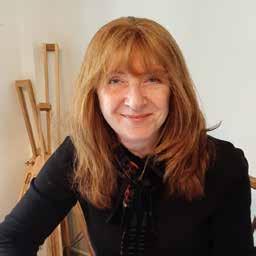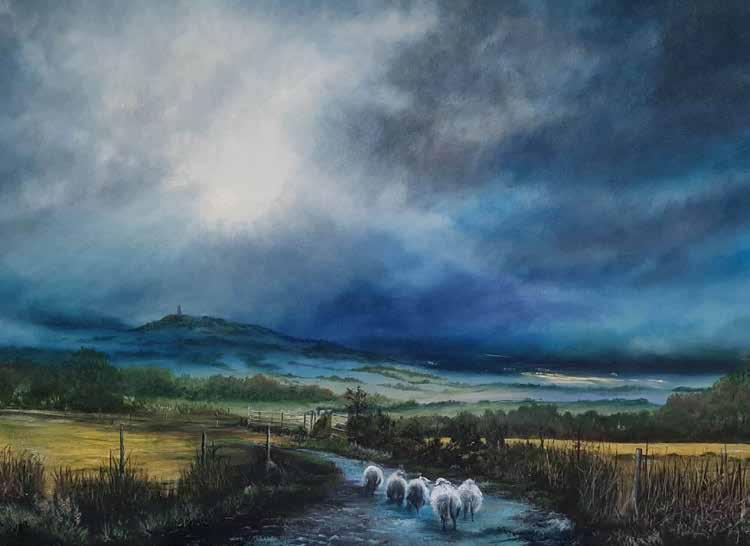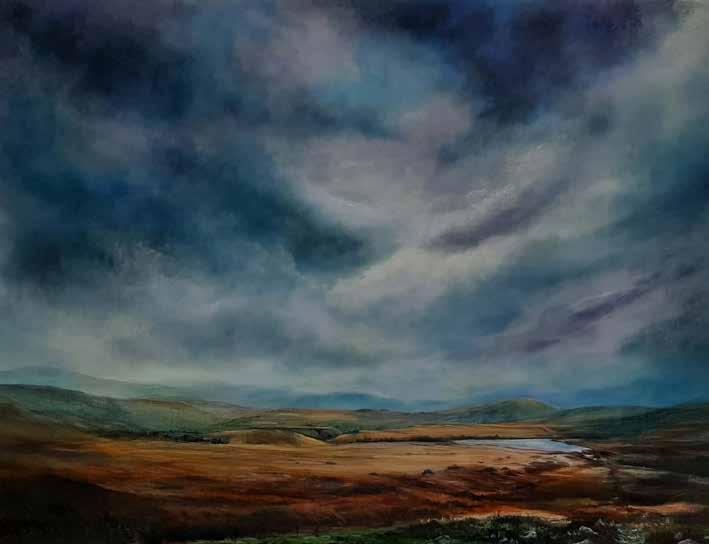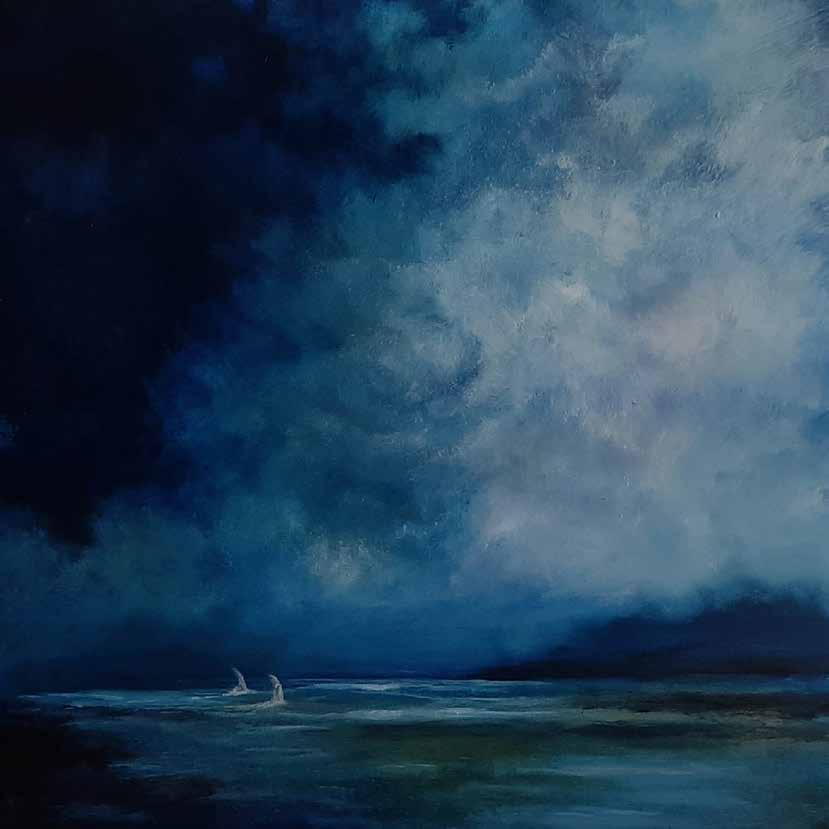
6 minute read
Jacky Rawlins
On the Yorkshire Art website, I look at some of Jacky Rawlins' work, such as View of Castle Hill and Mist Over Sandsend Ness, I am drawn to the sheep turning to the breaking light and there's a sense of hope in that light. When I look at Storm Over Marsden and Sailing at Sandsend, there's not so much light and - for me - a feeling of foreboding and threat. I wondered if these were Jacky's intentions for her audience, and whether they each reflect her mood - and if there's a story behind each painting.

Advertisement
View of Castlehill
Your comments on the paintings are accurate in how I wanted them to come across. I do have a story in mind when I paint. It might not always be evident to others. It might help to know that I am a Druid and have always been one, so nature is paramount to me in how I try and live my life - the landscape and the ancient stories it holds, how the ancestors worshipped the waterfalls, the stars and so on. I feel the wonder they must have felt as the seasons changed and nature being reborn every spring. To me, the light and its effects on the landscape are important, as every day it is different.I do try to capture the atmosphere of the sky in particular. Lots of it on the Pennines. I do try to impress the simple beauty and carved shapes of nature and add a little of man's influence, mainly in an archaeological sense. Our ancient history is important and as a Druid I hope one day we will all wake up to it. You are right about the storm over Marsden , the idea that the landscape had influenced our most recent ancestors to make use of the area during the industrial revolution, I added the mill into the painting, our heritage in this part of the world. However, it has that overarching menacing atmosphere of women and children put into slavery to keep those mills producing the goods. This bit seems to get lost in the current debate on slavery.
I asked Jacky if she is the first artist in her family.
Both my brother and I are the most creative. I think we take after my late dad. My brother designs and carves wood and creates using metals, just as our dad did . I have always painted.
Early memories of art
My Aunt had an art shop in Skelmanthorpe years ago and my parents made me a paint box and palette. Oil paints were added and a canvas prepared. I was about 14/15 years old at the time. I always took art at school but it was mostly draughtsmanship techniques and watercolour washes .
Studies after leaving school
I have had sessions with Martin Kinnear and Tom Wood and have online links to Dan Scott. I have studied artists' techniques, attended major exhibitions, read, watched on line and practised the techniques from both the work of the old masters and more contemporary artists. Apart from the above, I finished formal training at A level. To achieve the optical activity glazing is essential and therefore oil is the perfect medium for that.
What about other forms of art?
I have tried watercolour and acrylics but failed to attain the drama of the sky that I wanted.
I realise that much of your inspiration comes from your environment, but do you identify in any way with another artist?
Waterhouse, Turner, Constable and van Aivazovsky are my main technical sources as I paint using the indirect method ."
When do you decide a piece is finished? Is there a sense of not being able to do any more, or a sense of satisfaction that the work is what you intended it to be? When painting indirectly it does give me time to keep looking and assessing whether it is finished. Sometimes that feeling hits before my original plan so I stop. In other cases, I will have a painting framed then add to it as it feels incomplete after a time.

How much have your own travels influenced your art?
I tend to paint the landscapes that mean something to me. I walk along ancient pathways, and I followed the Pennine path Simon Armitage took for his poetry and the Stanza Stone Project - and I painted the views from the places his words are carved. We also have hundreds of old stones in Yorkshire (identified by Paul Bennett in the Old Stones of Elmet) and again lots of them are on the moors so there are perfect views across the valleys.


Over the years, I have travelled around the world but the places that I feel attached to are Iceland, Newfoundland, Scotland, Outer Hebrides, Orkney and New Zealand. I climbed mountains and volcanos and walked miles through different terrains, but it all seems to come back to the weather and the landscapes and the ancient ones.
Do you have a conflict with the commercial aspect of your work? In other words, does painting to sell hinder you or interfere with your freedom in any way?
When paintings go on display, I explain a little of the history which seems to inspire people to buy my work. I do commissions but again they tend to be local landscapes that I would paint. I did a portrait of a dog once as a commission but stressed it would be a dog in a landscape, which worked.
Looking to the future
I am moving along on my journey and have joined a small group of artists - the Yorkshire Colourists - who are all different in the work they produce. I find their techniques interesting and inspiring. Tom Wood is also a source of inspiration as he teaches different techniques, which I am now starting to really bring into my new work, but again based on my underlying relationship with nature and the need to record it in my work. I do set plans for the direction I want to go and document what I am doing, but inevitably it changes as interesting things occur. At the moment, the archaeological symbols I have found will start to appear more in this year's work and I will continue to strive to paint dramatic Pennine skies. I come to the end of my questions and reflect on the little I know about Druidism - its harmony and connection with the natural world, as well as respect for the traditions and our ancestors who centuries ago trod those paths with which Jacky is so familiar today. With her skill, she confirms her own connection and empathy with the changes that Nature provides through the seasons, and creates a permanent record with her oils which she can share.
Unexpectedly, as I stare at the winter landscape from my window, I imagine that I see those people of so long ago, walking down the lane that their ancestors also travelled - and I begin to understand Jacky Rawlins' sense of place and time.
Written by Mags Richards


Sailing at Sandsend: £125












